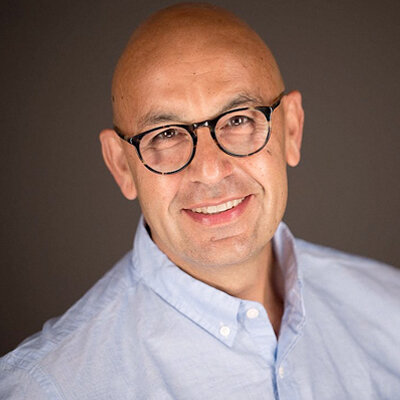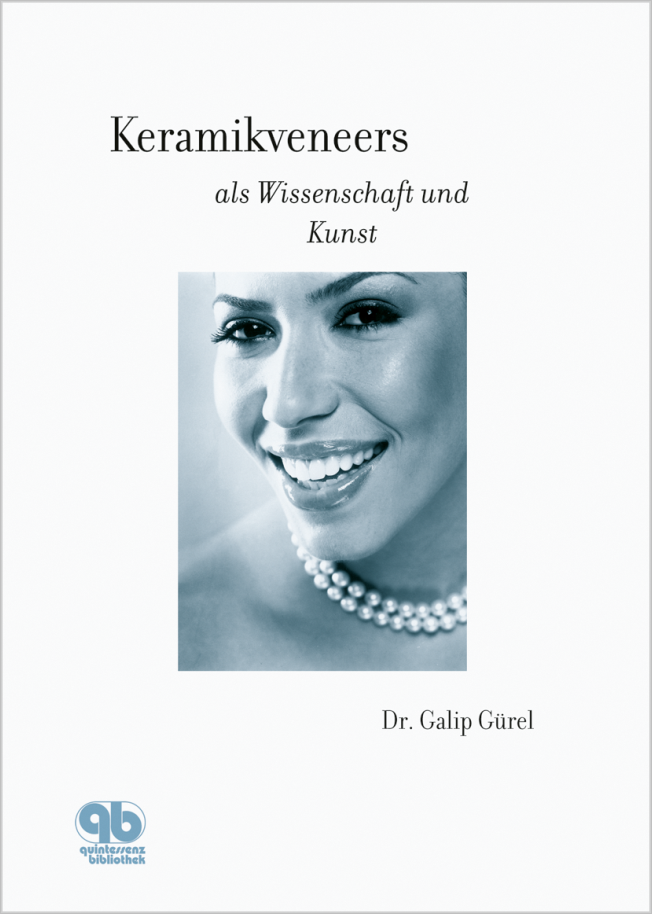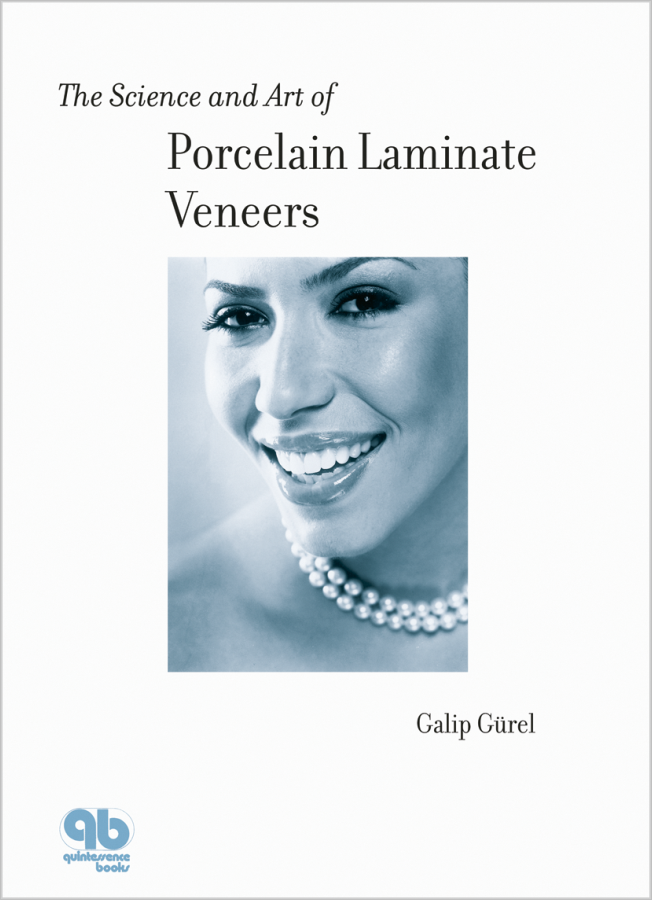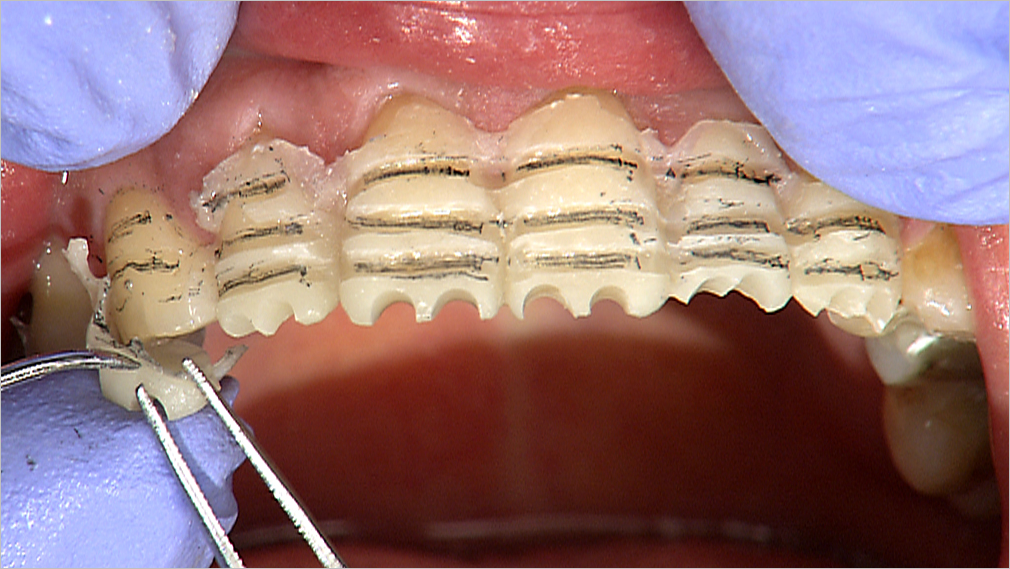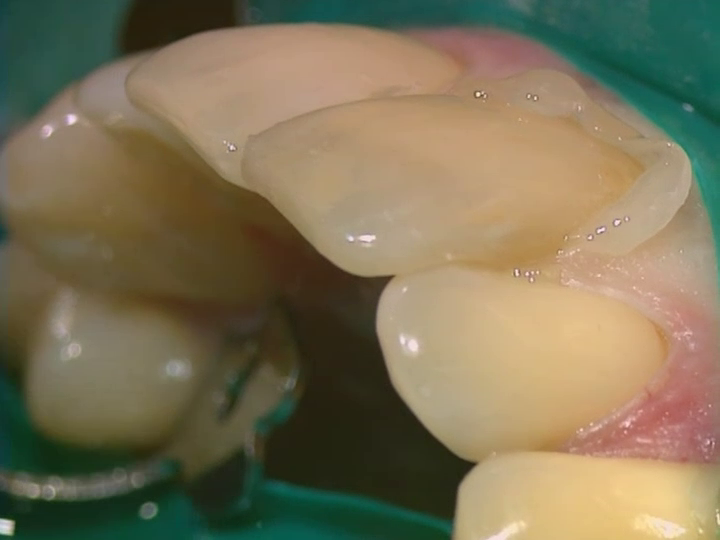International Journal of Esthetic Dentistry (DE), 4/2023
Clinical ResearchSeiten: 352-366, Sprache: DeutschNtovas, Panagiotis / Pashias, Alexis / Vassilopoulos, Spyridon / Gürel, Galip / Madianos, Phoebus / Papazoglou, EfstratiosEin digitaler WorkflowZiel: Dieser Beitrag beschreibt einen digitalen Workflow, in dem 3-D-Drucktechnik zur Herstellung von Schablonen für die ästhetische Kronenverlängerung und Kontrolle der Veneerpräparationen eingesetzt wird.
Klinischer Ablauf: Nach anfänglichen Intraoral- und Gesichtsscans wurde mit einer KI-basierten Software ein auf dem Persönlichkeits- und Gesichtstyp der Patientin basierender digitaler ästhetischer Entwurf (Smile Design) erstellt. Für das Mock-up wurde ein 3-D-gedruckter, auf einem gedruckten Modell mit Silikon unterfütterter Schlüssel verwendet. Die ästhetische Kronenverlängerung erfolgte geführt durch eine 3-D-gedruckte Schablone, die Leitkonturen für den geplanten neuen Gingivarand und das Alveolarknochenniveau aufwies. Zudem wurde auf Grundlage der initialen Planung ein Satz Präparationsschablonen erstellt und 3-D-gedruckt, welche zur Kontrolle und Korrektur der Veneerpräparationen dienten. Vor der Herstellung der definitiven monolithischen Restaurationen wurden deren Formen in Gestalt 3-D-gedruckter Prototypen überprüft. Schließlich wurde ein Aufbissbehelf digital konstruiert und 3-D-gedruckt, der zur Stabilisierung des Behandlungsergebnisses diente.
Schlussfolgerungen: Technologischer Fortschritt verbessert die Vorhersagbarkeit der Ergebnisse interdisziplinärer ästhetischer Behandlungen. Die virtuelle Planung kann im digitalen Workflow mithilfe geeigneter 3-D-gedruckter Schablonen zur Kontrolle der Behandlungsmaßnahmen zuverlässig in die Realität überführt werden.
Klinische Relevanz: Mit dem hier beschriebenen Workflow lassen sich gute Ergebnisse bei interdisziplinären Behandlungen mittels Kronenverlängerung und Veneers sicherstellen. Dabei werden sowohl die parodontalchirurgischen als auch die restaurativen Maßnahmen durch 3-D-gedruckte Schablonen geführt, die in einem individualisierten CAD/CAM-Prozess hergestellt wurden.
International Journal of Esthetic Dentistry (EN), 4/2023
Clinical ResearchPubMed-ID: 37819562Seiten: 330-344, Sprache: EnglischNtovas, Panagiotis / Pashias, Alexis / Vassilopoulos, Spyridon / Gürel, Galip / Madianos, Phoebus / Papazoglou, EfstratiosA digital workflowAim: To describe a digital workflow utilizing 3D printing technology to guide esthetic crown lengthening and control tooth preparation.
Clinical considerations: After the initial intraoral and face scans, an esthetic treatment plan was performed digitally based on the patient’s personality and face type using artificial intelligence-based 3D smile design software. A 3D-printed tray relined with silicone over a 3D-printed model was used for the mock-up. A 3D-printed guide was implemented to assist esthetic crown lengthening by incorporating, simultaneously, information about the desired free gingival line and the alveolar bone level. Based on the initial planning, a set of reduction guides was 3D printed to check and correct the tooth preparation. Prior to the start of construction of the final monolithic restorations, their design was verified using 3D-printed prototypes. A stabilization splint was digitally designed and 3D printed to protect and maintain the final result.
Conclusions: Technologic advances can improve the predictability of an interdisciplinary esthetic approach. Digital planning can be transferred to clinical reality using a digital workflow, utilizing a set of appropriate 3D-printed guides, which can help to control clinical procedures based on the initial planning.
Clinical significance: By following the proposed step-by-step workflow, clinicians can achieve predictable results through an interdisciplinary approach, guiding both the periodontal plastic surgery and the restorative treatment after an individualized CAD/CAD procedure for 3D-printed guides.
International Journal of Esthetic Dentistry (DE), 2/2022
IJED EspressoSeiten: 140-141, Sprache: Deutschvan Dooren, Eric / Cofar, Florin / Tokar, Anatoliy / Giordani, Gustavo / Popp, Ioana / Sousa Dias, Nuno / Stankov, Venceslav / Gurel, GalipInternational Journal of Esthetic Dentistry (EN), 2/2022
IJED EspressoPubMed-ID: 35586995Seiten: 138-139, Sprache: Englischvan Dooren, Eric / Cofar, Florin / Tokar, Anatoliy / Giordani, Gustavo / Popp, Ioana / Sousa, Nuno / Stankov, Venceslav / Gurel, GalipInternational Journal of Esthetic Dentistry (EN), 1/2021
PubMed-ID: 33502129Seiten: 10-32, Sprache: EnglischGürel, Galip / Paolucci, Braulio / Iliev, Georgi / Filtchev, Dimitar / Schayder, AdrianoEvery human smile is unique and special, reflecting the different shapes, textures, and colors of the teeth as well as their combinations. This uniqueness conveys a direct and specific message when it comes to creating a new smile design. Dentists need to consider the ‘unity of the whole’ concept in this task, which involves bringing together biology, structure, function, and esthetics to create the fifth dimension of the smile. This approach is quite different from the traditional one. A smile reflects the personality and emotional state of the patient, and the translation of this into a new smile design occurs in various ways. This can be performed either through analog methods or digitally; however, the use of visual language will assist the dentist and dental technician in the creation of a personalized smile design. Nowadays, with the significant digital advances that have occurred in dentistry, there are systems on the market that help the dental team to create a personalized new smile design for each specific patient. The Rebel system is one example of such a system. It is actually a virtual laboratory that creates individualized smile designs in three dimensions. The system, with its very sophisticated artificial intelligence (AI)-based software, immediately creates a digital wax-up (STL file). It is therefore simple to use for dentists and dental technicians at all skill levels because the direct mock-up and wax-up stages are eliminated.
International Journal of Esthetic Dentistry (DE), 1/2021
Seiten: 10-33, Sprache: DeutschGürel, Galip / Paolucci, Braulio / Iliev, Georgi / Filtchev, Dimitar / Schayder, AdrianoDas menschliche Lächeln ist aufgrund unterschiedlicher Zahnformen, -oberflächen und -farben und ihrer Kombinationen einzigartig und besonders. Damit entsteht eine sehr direkte und konkrete Aufgabe, wenn ein neues Lächeln kreiert werden soll: Der Zahnarzt muss die „Einheit des Ganzen“ berücksichtigen, also Biologie, Struktur, Funktion und Ästhetik zusammenführen, um die fünfte Dimension des Lächelns zu kreieren. Dieser Ansatz unterscheidet sich deutlich vom klassischen Konzept. Das Lächeln zeigt die Persönlichkeit und die emotionale Verfassung des Patienten, deren Überführung in eine neue dentale Ästhetik analog oder digital geschehen kann. Die Nutzung visueller Sprache unterstützt Zahnärzte und Zahntechniker bei der Gestaltung eines individuellen Lächelns. Dank erheblicher Fortschritte in der digitalen Zahnmedizin sind inzwischen Systeme verfügbar, mit deren Hilfe das Behandlungsteam ein individuelles Smile Design für jeden Patienten erstellen kann. Ein Beispiel hierfür ist das Rebel-System. Hierbei handelt sich um ein virtuelles Zahntechniklabor, das individualisierte Entwürfe für ein neues Lächeln in 3-D liefert: Mithilfe hochentwickelter Software auf Basis künstlicher Intelligenz erstellt das System ein digitales Wax-up im STL-Format. Die Anwendung ist auch für unerfahrene Zahnärzte und Zahntechniker leicht, da die Arbeitsschritte des direkten Wax-ups und Mock-ups entfallen.
QZ - Quintessenz Zahntechnik, 8/2020
InnovationSeiten: 892-909, Sprache: DeutschGürel, Galip / Paolucci, Braulio / Iliev, Georgi / Filtchev, Dimitar / Schayder, AdrianoKonvertierung eines 2-D-Entwurfs zum 3-D-Modell mit der Rebel-SoftwareDer französische Künstler Philip Hallawell hat die Theorie des Visagismus entworfen, wonach der Ausdruck eines Gesichts aufgrund seiner geometrischen Typologie in einem inneren Zusammenhang mit dem Gefühl persönlicher Identität steht. Er bezieht sich dabei auf die Lehre von den vier Temperamenten, die der antike Arzt Hippokrates skizziert hatte. Die Rebel-Software der bulgarischen Fa. Visagismile wiederum ist in der Lage, das Gesicht zu erfassen, eine Bewertung des Temperaments durchzuführen, die persönlichen Präferenzen des Patienten zu analysieren und diese Informationen in Mathematik zu übersetzen. Der Beitrag schildert einen Fall, bei dem die Software für eine Restauration von Frontzähnen zum Einsatz kam.
Schlagwörter: digitale Zahntechnik, Temperament, Smile Design, Persönlichkeit, Rebel-Software
International Journal of Periodontics & Restorative Dentistry, 2/2018
DOI: 10.11607/prd.3186, PubMed-ID: 29447311Seiten: 189-197, Sprache: EnglischKoubi, Stefen / Gurel, Galip / Margossian, Patrice / Massihi, Richard / Tassery, HerveTreatment of tooth wear has increased over the last two decades. However, the treatments involved have not been satisfactory to most patients, nor have they achieved the expected goal on some worn teeth. New approaches have emerged to reconstruct full arches in a minimally invasive way that take advantage of developments in the field of adhesive dentistry. These new concepts constitute a revolution in dentistry and their application requires adapted techniques and training. The purpose of this article is to suggest a precise and reproducible method that simplifies the treatment of worn dentition. A wax-up and a mock-up are primarily used to design the esthetic outcome and then used as a guide for the preparation of anterior teeth or the occlusal surfaces of posterior teeth. This not only provides the exact new vertical dimension of occlusion but serves as a guide for precisely controlling occlusal preparation simultaneously with buccal preparation. The classical cavity design for a partial bonded restoration on posterior worn dentition is also reviewed. The authors believe that during the preparation of the occlusal surfaces of the posterior teeth surfaces, the marginal ridges must be preserved to reduce the biologic cost and mechanical stress leading to fracture. A new type of thin and reduced restoration called tabletop is presented.
International Journal of Periodontics & Restorative Dentistry, 4/2014
DOI: 10.11607/prd.1900, PubMed-ID: 25006762Seiten: 452-459, Sprache: EnglischCoachman, Christian / Gurel, Galip / Calamita, Marcelo / Morimoto, Susana / Paolucci, Braulio / Sesma, NewtonVarious types of dental preparations for laminate veneers have been proposed, depending on factors such as the properties of the ceramic material, remaining dental structure color, need for altering the dental contour, laboratory fabrication technique, and occlusal relationships. Clinical observations of successes and failures associated with the development of techniques and materials have allowed some safe parameters to be delineated for effectively performing dental preparations for ceramic veneers or even placing veneers without any preparation. This article describes the use of an additive diagnostic wax-up that is transferred to the mouth by means of an intraoral mock-up (aesthetic pre-evaluative temporary) with associated mathematic parameters to guide dental preparations. This technique, called Do the Math and presented here in the form of a clinical case report, aims to avoid excessive or incorrect tooth preparation by indicating the exact amount and location of the tooth reduction necessary to attain the desired color and shape.
QZ - Quintessenz Zahntechnik, 2/2014
Step by StepSeiten: 180-188, Sprache: DeutschGürel, Galip / Yerusalmi, Birgul Metin / Shayder, AdrianoDie Autoren erläutern step by step die Herstellung einer minimalinvasiven ästhetischen Oberkieferfrontzahnversorgung aus CAD/CAM-gefertigten monolithischen Veneers. Die Individualisierung der Veneers erfolgte durch Oberflächenbemalung.
Schlagwörter: Ästhetik, Zahnfleischlächeln, Veneers, monolithische CAD/CAM-Keramik-Veneers, Wax-up, Mock-up, Provisorien, Individualisierung, Oberflächenbemalung



